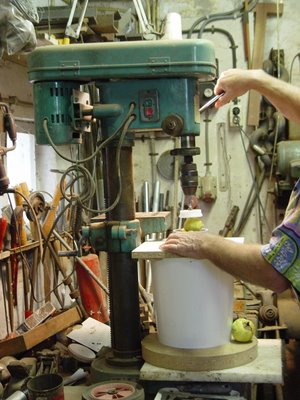De noten vallen!
The nuts are falling!

Soms pak ik dan zo'n groen ding en snijdt 'm doormidden. Dat kan want de bast van de werkelijke noot is dan nog zacht. Alles, de groene schil, de bast en noot zijn dan sappig en zacht. Voor die groene noten zijn er ook aardig wat recepten maar daar komen wij volgend jaar op terug. Als de noot rijp is barst de dikke groene schil open en zal de noot er uitvallen. Kraaiachtigen zijn gek op noten, zij zijn er vaak eerder bij dan wij. Ze komen in grote getallen aanvliegen vanuit de hoge populieren in de buurt. De noten laten ze vanuit de lucht op de weg te barsten vallen, waarna ze ze lekker op kunnen peuzelen.
There are five nuts trees standing between the dyke and our vegetable garden. In the early summer people often ask us what kinds of trees they are. They're surprised when I tell them they're walnut trees: "Those green things, are they walnuts?"
So sometimes I pick one of those green things and cut it in half. That is easy because at the time the husk of the actual nut is still soft. Everything, the green skin, the husk and the nut are juicy and soft. There are a few recipes for unripe nuts but we'll return to those next year. When the nut is ripe, the thick green skin bursts open and the nut falls out. Crows are crazy about nuts, and usually get to them before we do. They come flying over in large numbers out of the nearby poplar trees, pick the nuts and let them fall from a height onto the dyke road. They break open and the crows can then pick them empty.

Soms begint de schil al te rotten of te verdrogen als de noot er nog niet uit is. Meestal kan dat geen kwaad maar soms tast het ook de noot aan. In ieder geval levert het mooie plaatjes op. Goed is te zien hoe de noot door z'n 'navelstrengen' zo lang mogelijk wordt vast gehouden. Als er nu een stevige wind opsteekt 'regent' het noten.
Sometimes the skin starts rotting or drying up hard before the walnut has fallen out. Mostly this is no problem, but sometimes it does affect the nut. In any case, it makes for a nice picture. It's interesting to see how the nut is held fast for as long as possible by its 'umbilical cord'. The minute a strong wind blows, the nuts start 'raining' down.
The gathered nuts are placed to dry on an open sieve of coarse mesh. That way, sun and wind can do their work drying them, while making it easy to remove earth and dirt. Of the five trees, one is a so-called 'double nut', which is the large one on the photo. The rest of the trees give smaller, rounder nuts. The smallest taste best, especially when they are still 'wet', as it were.


Finally, we use a small bucket (approx. 1400 grammes) as a measure to pour the nuts into a net, which we hang up by the rest of our 'wares'. Today I sold eight nets of nuts and three pumpkins. Not bad going, is it?







































